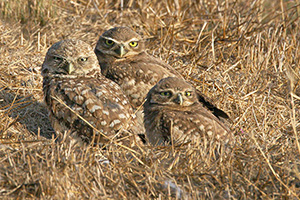Pellets |
|
|---|---|

photograph of Burrowing Owls by Tom Grey |
Owls
do exactly what children are warned against -- they swallow
their food whole, or nearly so. When they eat a small
vertebrate, they digest all but the bones and fur or
feathers. They regurgitate those remains in the form of a
hard, felted or feathered pellet -- one per victim. Where
owls feed on insects, each regurgitated pellet contains the
indigestible parts of the exoskeletons of numerous
individuals. Ejecting indigestible portions of food in the form of pellets is also common in raptors and gulls, and has been recorded in many other groups of birds, including flycatchers, corvids, herons, sandpipers, kingfishers, and even honeyeaters (primarily Australian birds that supplement their nectar/fruit diets with insects). |
| Pellets, especially those of birds that swallow their prey whole, provide ornithologists with records of what the birds are eating at various times and in various places. The hard pellets last a long time in dry climates and can be collected in numbers near roosts. If soaked in warm water, carefully dissected, and examined under magnification, the identity of vertebrate prey often can be determined from the bones. The pellets of raptors such as eagles and hawks are less useful, since they tear much of the flesh from their victims, and do not swallow the bones. | |
| SEE:
Diet and Nutrition;
Determining Diets. Copyright ® 1988 by Paul R. Ehrlich, David S. Dobkin, and Darryl Wheye. |
|